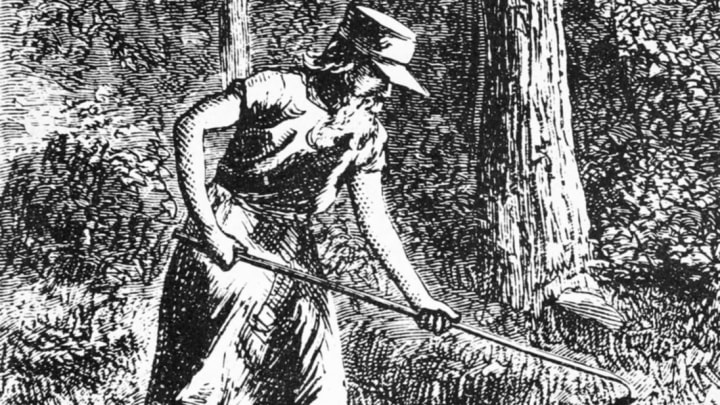A hero of American folklore, Johnny Appleseed was said to be a barefoot wanderer with a tin pot hat, and a sack of apples, so he might leave the start of trees everywhere he went. But unlike his tall tale colleagues Paul Bunyan and Babe the Blue Ox, Appleseed's story was based on a real man. His name was John Chapman, and his real life was far richer and more interesting than his legend. Here are nine things you might not have known about the man behind the myth, in honor of Johnny Appleseed Day.
1. HE WAS A CHILD OF WAR.
Born in Leominster, Massachusetts, on September 26, 1774, John Chapman grew up in the midst of the American Revolutionary War, in which his father served as a minuteman at the Battle of Bunker (Breeds) Hill and helped construct the defenses of New York against British invasion with George Washington. While his father would survive the war, Chapman's mother did not, dying in childbirth in July 1776. In 1780, Chapman's father returned home, and began to teach his son the farming trade.
2. HE WAS NO MEANDERING PLANTER.
Chapman developed as an orchardist and nurseryman, and by the early 1800s was working on his own. While his legend imagines him as a messy nomad, in reality, Chapman was much more pragmatic. Frontier law allowed people to lay claim to land through development of a permanent homestead. Such a claim could be made by planting 50 apple trees. So in his travels through Pennsylvania, Ohio, and Illinois, Chapman would plant swaths of seeds to begin an orchard, then sell them to settlers once the land had grown bountiful. This made him quite the land baron as he traversed 100,000 square miles of Midwestern wilderness and prairie. When he died on March 11, 1845 at the age of 70, he owned more than 1200 acres of land.
3. HIS APPLES WEREN'T FOR EATING.
The apples that Chapman favored for planting were small and tart "spitters"—named for what you'd likely do if you took a bite of one. But this made them ideal for making hard cider and applejack. This was a far more valuable crop than edible apples. In The Botany of Desire, Michael Pollan wrote:
Up until Prohibition, an apple grown in America was far less likely to be eaten than to wind up in a barrel of cider. In rural areas cider took the place of not only wine and beer but of coffee and tea, juice, and even water.
Where water could house dangerous bacteria, cider was safe. (And delicious.)
4. HIS SIGNATURE LOOK IS PRETTY TRUE TO LIFE.
Chapman was often noted for his threadbare clothes and preference for bare feet. But these eccentricities may have been offerings to his faith, the Church of Swedenborg (also known as The New Church), a Christian denomination established in 1787. The second part of his signature look—that sack of apple seeds—was most definitely accurate. Because the Church forbade its members harming God's creation, Chapman became a vocal animal rights activist and vegetarian. He also refused to use grafting to create his orchards, believing that this growing technique physically hurt the source plants. So, he carried a large sack of seeds everywhere he traveled. However, his oft-depicted tin pot hat has not been authenticated.
5. HE PLANTED NO METAPHORICAL SEED.
Another strongly held belief of Chapman's was that marriage was not for him. As the Church of Swedenborg promoted abstinence for those unmarried, Chapman remained chaste his entire life, leaving no children to inherit his lands or curtail the tall tales that sprouted like his trees did.
6. IN DEATH, HE GREW LEGENDARY.
Though some say Chapman had picked up his nickname by 1806, it wasn't until after his death in 1845 that the legend of Johnny Appleseed really took off. Considering his distinctive look, uncommon views, and contribution to the settling of the frontier, it's little wonder his legend proved so powerful. Of course, over the years he was made to seem less entrepreneurial and the use of his apples was played down as they made their way into children's books and this Disney cartoon:
7. PROHIBITION KILLED MUCH OF HIS LEGACY.
By the time the U.S. government outlawed alcohol in 1920, Chapman had become an American folk hero. But this didn't stop the axes of FBI agents who mercilessly tore down orchards to prevent the making of homemade hooch. Aside from slaughtering Chapman's trees, this also nearly killed America's connection to hard cider. The beverage rooted deep in our history has only recently seen a resurgence in popularity.
8. YOU CAN STILL VISIT ONE OF HIS TREES.
Nova, Ohio, is home to a 176-year-old tree, the last known to be planted by Johnny Appleseed himself. It grows tart green apples, which are now used for applesauce and baking in addition to cider making. While Chapman might be glad to see his seeds still bearing fruit, he'd likely be sad to hear this tree is a noted bud source for grafting new apple trees.
9. HE FOREVER CHANGED THE APPLES OF AMERICA.
Pollan credits Chapman's preference for seeds over grafting for creating not only varieties like the delicious and golden delicious, but also the "hardy American apple." Since apples that are grafted are the same as the parent tree, they don’t change. But by forgoing grafting, Johnny created the conditions for apple trees to adapt and thrive in their new world home.
"It was the seeds, and the cider, that give the apple the opportunity to discover by trial and error the precise combination of traits required to prosper in the New World," Pollan wrote. "From Chapman's vast planting of nameless cider apple seeds came some of the great American cultivars of the 19th century."
